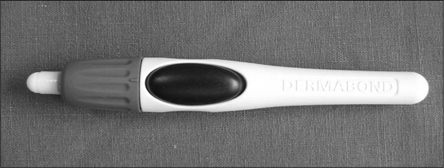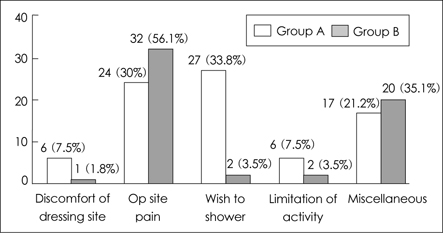J Korean Neurotraumatol Soc.
2009 Dec;5(2):57-61. 10.13004/jknts.2009.5.2.57.
Efficacy of 2-Octylcyanoacrylate Glue in Minimal Invasive Spine Surgery
- Affiliations
-
- 1Department of Neurosurgery, Kangdong Sacred Heart Hospital, College of Medicine, Hallym University, Seoul, Korea. moonkyu71@hallym.or.kr
- KMID: 1427358
- DOI: http://doi.org/10.13004/jknts.2009.5.2.57
Abstract
OBJECTIVE
Topical 2-Octylcyanoacrylate (Dermabond(R), Ethicon, Inc., Somerville, NJ) tissue adhesive glue is an alternative to traditional devices for closing short surgical incisions and laceration wounds. Dermabond provides cosmetic closure and very low infection risks. There were rare published studies using Dermabond(R) in spine surgery. This study was undertaken to determine the efficacy to use in spine surgery.
METHODS
From April 2006 to May 2007, 57 consecutive patients (29 male and 28 female) who was performed spinal surgeries (micro/endoscopic discectomy, microscopic fenestration) in our hospital. Complications related to operative wounds and patient satisfactions were analyzed.
RESULTS
Of 57 patients, 25 underwent microlumbar discectomy, 3 endoscopic lumbar discectomy, 3 lumbar laminectomy, and 26 anterior cervical discectomy. There was no wound infection, 2 wound dehiscence, 1 pruritus itch in the covered site. Mean period for Dermabond(R) to detach was 2.85 weeks and the length of incision ranged from 0.5 cm to 10 cm. Fifty four of 57 patients want to use the adhesive glue for other wound in the future instead of conventional suture methods.
CONCLUSION
Our results support that 2-Octylcyanoacrylate is a safe alternative to traditional devices for closing short surgical incisions in operation.
MeSH Terms
Figure
Reference
-
1. Bhende S, Rothenburger S, Spangler DJ, Dito M. In vitro assessment of microbial barrier properties of Dermabond topical skin adhesive. Surg Infect (Larchmt). 2002; 3:251–257.
Article2. Bruns TB, Worthington JM. Using tissue adhesive for wound repair: a practical guide to dermabond. Am Fam Physician. 2000; 61:1383–1388.3. Charters A. Wound glue: a comparative study of tissue adhesives. Accid Emerg Nurs. 2000; 8:223–227.
Article4. Cho J, Harrop J, Veznadaroglu E, Andrews DW. Concomitant use of computer image guidance, linear or sigmoid incisions after minimal shave, and liquid wound dressing with 2-octyl cyanoacrylate for tumor craniotomy or craniectomy: analysis of 225 consecutive surgical cases with antecedent historical control at one institution. Neurosurgery. 2003; 52:832–840. discussion 840-841.
Article5. Farion K, Osmond MH, Hartling L, Russell K, Klassen T, Crumley E, et al. Tissue adhesives for traumatic lacerations in children and adults. Cochrane Database Syst Rev. 2002; CD003326.
Article6. Hall LT, Bailes JE. Using dermabond for wound closure in lumbar and cervical neurosurgical procedures. Neurosurgery. 2005; 56:147–150. discussion 147-150.
Article7. Kim HJ, Ha YR, Kim YS, Kim JH, Kim SC, Kim JC, et al. Tissue adhjesive versus simple suture for wound management in children under 5 years of age in the emergency department. J Korean Soc Emerg Med. 2003; 14:508–513.8. Kim YM, Gupta BK. 2-octyl cyanoacrylate adhesive for conjunctival wound closure in rabbits. J Pediatr Ophthalmol Strabismus. 2003; 40:152–155.
Article9. Lee KW, Sherwin T, Won DJ. An alternate technique to close neurosurgical incisions using octylcyanoacrylate tissue adhesive. Pediatr Neurosurg. 1999; 31:110–114.
Article10. Magee WP Jr, Ajkay N, Githae B, Rosenblum RS. Use of octyl-2-cyanoacrylate in cleft lip repair. Ann Plast Surg. 2003; 50:1–5.
Article11. Malone DL, Genuit T, Tracy JK, Gannon C, Napolitano LM. Surgical site infections: reanalysis of risk factors. J Surg Res. 2002; 103:89–95.
Article12. Matin SF. Prospective randomized trial of skin adhesive versus sutures for closure of 217 laparoscopic port-site incisions. J Am Coll Surg. 2003; 196:845–853.13. Mattick A, Clegg G, Beattie T, Ahmad T. A randomised, controlled trial comparing a tissue adhesive (2-octylcyanoacrylate) with adhesive strips (Steristrips) for paediatric laceration repair. Emerg Med J. 2002; 19:405–407.
Article14. Ryu WY, Yoo KW. Comparison of 2-octylcyanoacrylate and suture with 8-0 polyglactin for conjunctival wound closure in rabbits. J Korean Ophthalmol Soc. 2005; 46:896–903.15. Swan MC, Descamps MJ, Broadhurst A. Scar tattooing following the use of tissue adhesive. Plast Reconstr Surg. 2006; 117:1054–1055.
Article16. Toriumi DM, O'Grady K. Surgical tissue adhesives in otolaryngology-head and neck surgery. Otolaryngol Clin North Am. 1994; 27:203–209.
Article
- Full Text Links
- Actions
-
Cited
- CITED
-
- Close
- Share
- Similar articles
-
- Use of 2-Octylcyanoacrylate (Dermabond(R)) on Breast Surgery
- Use of 2-Octylcyanoacrylate(Dermabond(R)) for Repair of Pediatric Facial Lacerations
- Use of 2-Octylcyanoacrylate (Dermabond(r)) for Repair of Hand Trauma
- Comparison of 2-Octylcyanoacrylate and Suture with 8-0 Polyglactin for Conjunctival Wound Closure in Rabbits
- Extensive Spinal Epidural Abscess: The Usefulness of Minimal Invasive Surgical Technique using Epidural Irrigation Catheter




